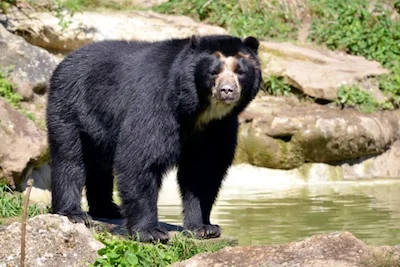These bears climb trees very well.
They eat lots of plants but eat some meat too.
They are awake at night.
They sleep in nests in the daytime.
They look like they wear glasses, which are also called spectacles.
©Getty Images
General facts about all bears:
Bears are mammals.
Bears are found in many habitats in different countries.
Bears all have a large body with strong legs and a short tail. They have a snout rather like a dog's snout. They have thick fur. Their paws have five claws that do not pull back like a cat's claws do.
Bears generally live alone, except when a mother is raising cubs.
There are eight different kinds of bear.
See a map of where all the different kinds of bear are found
They don't actually wear spectacles! Getty
Spectacled bears are also known as Andean bears, named after the Andes Mountains of South America, where they live.
They are the only kind of bear on the continent of South America, found in the South American countries of Venezuela, Columbia, Ecuador, Peru, and Bolivia.
What do spectacled bears look like?
©Getty Images
The spectacled bear gets its name from the whitish or yellowish marks around its eyes that make it look like it is wearing glasses, or spectacles. Each bear has slightly different markings, and some don’t have them at all, so that no two bears look exactly the same.
A spectacled bear has shaggy fur that is black, brown, or sometimes reddish in colour. This kind of bear is one of the smallest of the bears. Females weigh about 82 kg, but the males are bigger, weighing about 154 kg and growing to about 1.5 metres long.
What is their habitat and distribution (where they are found)?
A 'cloud forest' in Ecuador ©Getty Images
They mostly live in very thick forests. They prefer the isolated ‘cloud forests’ high up in the Andes mountains. Cloud forests are called that because of the fog that forms much of the time at the top part of the trees, or the canopy.
However, spectacled bears can also be found in the South American rainforests, grasslands and coastal desert.
What are their behaviours?
©Getty Images
Spectacled bears are excellent tree climbers, probably the best of all eight bear species. Their front legs are slightly longer than their back legs to help them climb trees better. They are diurnal, or awake during the daytime and asleep in the night. They sleep in nests they make in trees or on the ground. They live alone most of the time, except for when a female is raising her cubs. These bears are shy and hard to spot, especially as they live in remote areas.
What do they eat?
A bromiliad, popular food of spectacled bears ©Getty Images
Spectacled bears eat a diet of fruit, berries, cacti, grasses, orchids and honey. They also eat insects, birds and small animals.
They especially love the different plants of the bromeliad family, all of which are plentiful in South American forests. Some bromeliads grow in the ground and some attach themselves to tree trunks and branches.
©Getty Images
Life cycle
Females give birth to one or two cubs at a time. The cubs are born in summer. They are very small and helpless at birth, but start moving around after about a month.
They sometimes ride on their mother's back. They stay with their mother for about a year.
Conservation status and threats to survival
Spectacled bears are listed as Vulnerable. If they are not protected, they will soon be classified as Endangered. They are very shy bears and hard to find in the thick, remote forests, so exact numbers are not known, but it is estimated that there are less than 3,000 spectacled bears left in the wild.
Their main threat is the destruction of their habitat, and that it is often in small patches rather than big areas (fragmentation). Poachers also hunt them for their meat and body parts, and farmers kill them as pests.
If the habitat can be preserved, the spectacled bear as well as many other animals and plants will be saved.
Published by Harper Collins
Did you know?
In the series of books about him, Paddington Bear came from 'deepest darkest Peru', so he must be a spectacled bear!
©Getty Images










